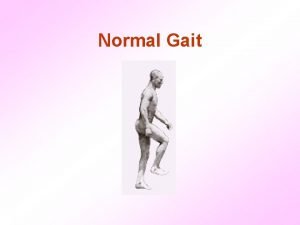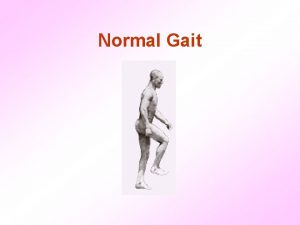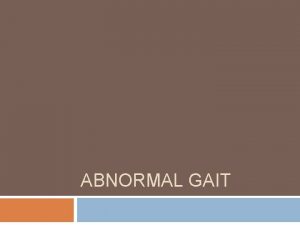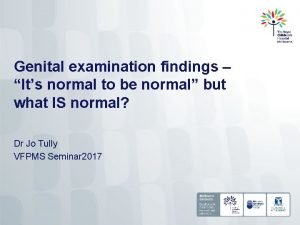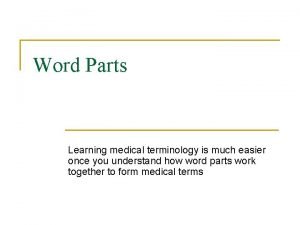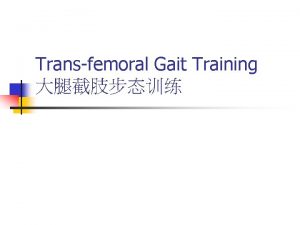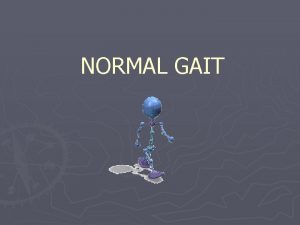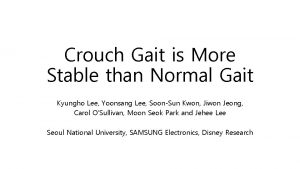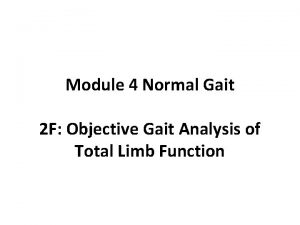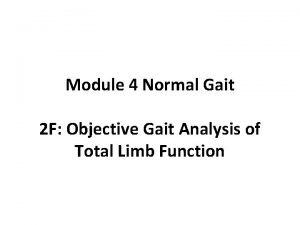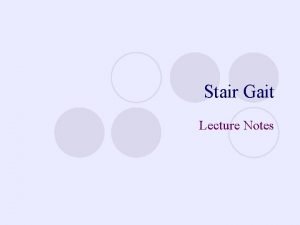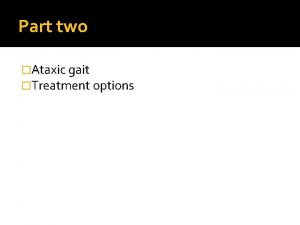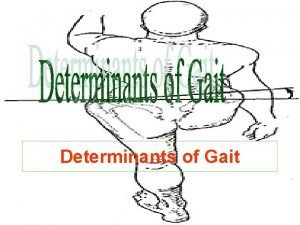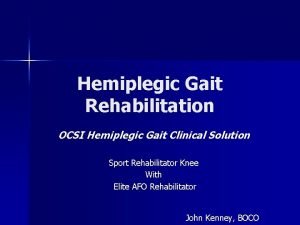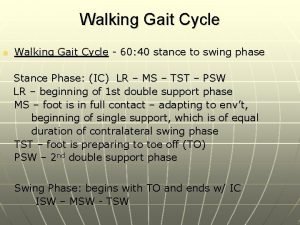Normal Gait Gait is the medical term to


















- Slides: 18

Normal Gait

• Gait is the medical term to describe human locomotion, or the way that we walk. Interestingly, every individual has a unique gait pattern.

Definition: • Physiological Definition: • It is a mechanism which depends upon closely integrated action of the subjects, bones, muscles and nervous system (including peripheral and central nervous system) • The degree of integration determines the different gait patterns. Any defect of any part of them or all of them will lead to pathological gait. • Mechanical definition; • It is a form of bipedal locomotion as there is an alternating action between lower extremities. One leg is in touch with the ground for restraining, supporting and propulsion. • The other leg is in swing phase for creating a new step forward. So gait is the result of a series of rhythmic alternating movement of arms, legs, and trunk which create forward movement of the body.

Prerequisites of gait There are (4) major criteria essential to walking. • Equilibrium: The ability to assume an upright posture and maintain balance. • Locomotion: The ability to initiate and maintain rhythmic stepping • Musculoskeletal Integrity: Normal bone, joint, and muscle function • Neurological Control: Must receive and send messages telling the body how and when to move. (visual, vestibular, auditory, sensori-motor input) • Forces for gait: Muscular force. Gravitational force. Forces of momentum. Floor reaction force.

Gait cycle • The gait cycle is used to describe the complex activity of walking, or our gait pattern. This cycle describes the motions from initial placement of the supporting heel on the ground to when the same heel contacts the ground for a second time.

Phases of Gait

Each gait cycle can be described in the phasic terms. • Stance Phase: • Is defined as the interval in which the foot is on the ground (60% of the gait cycle). • Stance Phase is divided into: 1)Heel strike to foot flat 2) Foot flat through mid-stance 3) Mid-stance through Heel off 4) Heel off to Toe off.

• The stance period consists of the first five phases: initial contact, loading response, mid-stance and terminal stance.

1) Initial Contact Initial contact is an instantaneous point in time only and occurs the instant the foot of the leading lower limb touches the ground. Most of the motor function that occurs during initial contact is in preparation for the loading response phase that will follow. Initial contact represents the beginning of the stance phase. Heel strike and heel contact serve as poor descriptors of this period since there are many circumstances when initial contact is not made with the heel alone. The term "foot • strike" sometimes is used as an alternative descriptor .

2) Loading Response • • The loading response phase occupies about 10 percent of the gait cycle and constitutes the period of initial double-limb support. During loading response, the foot comes in full contact with the floor, and body weight is fully transferred onto the stance limb. The initial double-support stance period occasionally is referred to as initial stance. The term foot flat (FF) is the point in time when the foot becomes plantar grade. The loading response period probably is best described by the typical quantified values of the vertical force curve. The ascending initial peak of the vertical force graph reveals the period of loading response.

3) Mid-stance • Mid-stance represents the first half of single support, which occurs from the 10 - to 30 -percent periods of the gait cycle. It begins when the contra-lateral foot leaves the ground and continues as the body weight travels along the length of the foot until it is aligned over the forefoot. The descending initial peak of the vertical force graph reveals the period of mid-stance

4)Terminal Stance • • • Terminal stance constitutes the second half of single-limb support. It begins with heel rise and ends when the contra-lateral foot contacts the ground. Terminal stance occurs from the 30 - to 50 - percent periods of the gait cycle. During this phase, body weight moves ahead of the forefoot. The term heel off (HO) is a descriptor useful in observational analysis and is the point during the stance phase when the heel leaves the ground. The ascending second peak of the vertical force graph demonstrates the period of terminal stance. Roll off describes the period of late stance (from the 40 - to 50 - percent periods of the gait cycle) when there is an ankle plantar-flexor moment and simultaneous power generation of the triceps surae to initiate advancement of the tibia over the fulcrum of the metatarsal heads in preparation for the next phase

2) Swing Phase: • is defined as the interval in which the foot is not in contact with the ground (40% of the gait cycle). denotes the time when the foot is in the air, constituting the remaining 38 percent of the gait cycle. The swing phase could be defined as the phase when all portions of the foot are in forward motion.

Swing is divided into two phases: 1) Acceleration to mid-swing 2) Mid-swing to deceleration • The swing period primarily is divided into three phases: initial swing, mid-swing and terminal swing. Preswing, however, prepares the limb for swing advancement and in that sense could be considered a component of swing phase.

Pre-swing • • • Pre-swing is the terminal double-limb support period and occupies the last 12 percent of stance phase, from 50 percent to 62 percent. It begins when the contralateral foot contacts the ground and ends with ipsilateral toe off. During this period, the stance limb is unloaded and body weight is transferred onto the contra-lateral limb. The descending portion of the second peak of the vertical force graph demonstrates the period of pre-swing. Terminal contact (TC), a term rarely used, describes the instantaneous point in the gait cycle when the foot leaves the ground. It thus represents either the end of the stance phase or the beginning of swing phase. In pathologies where the foot never leaves the ground, the term foot drag is used. In foot drag, the termination of stance and the onset of swing may be somewhat arbitrary. The termination of stance and the onset of swing is defined as the point where all portions of the foot have achieved motion relative to the floor. Likewise, the termination of swing and the onset of stance may be defined as the point when the foot ends motion relative to the floor. Toe off occurs when terminal contact is made with the toe.

b) Initial Swing • The initial one-third of the swing period, from the 62 - to 75 -percent periods of the gait cycle (6), is spent in initial swing. It begins the moment the foot leaves the ground and continues until maximum knee flexion occurs, when the swinging extremity is directly under the body and directly opposite the stance limb.

c) Mid-swing occurs in the second third of the swing period, from the 75 - to 85 -percent periods of the gait cycle. Critical events include continued limb advancement and foot clearance. This phase begins following maximum knee flexion and ends when the tibia is in a vertical position.

d) Terminal Swing • In the final phase of terminal swing from the 85 - to 100 percent periods of the gait cycle, the tibia passes beyond perpendicular, and the knee fully extends in preparation for heel contact.
 Prerequisites of gait
Prerequisites of gait Prerequisites of gait
Prerequisites of gait Medical position terms
Medical position terms Types of gait
Types of gait Hymen
Hymen Short term planning and long term planning
Short term planning and long term planning In my understanding
In my understanding Long term memory vs short term memory
Long term memory vs short term memory Term-to-term rule
Term-to-term rule Short term hr planning
Short term hr planning Position-to-term rule
Position-to-term rule Difference between long term and short term liabilities
Difference between long term and short term liabilities Long term liabilities
Long term liabilities Minterm maxterm
Minterm maxterm Rules in finding the nth term
Rules in finding the nth term Term to term rule
Term to term rule Short term goal
Short term goal Short-term financial management
Short-term financial management Three types of word parts
Three types of word parts
